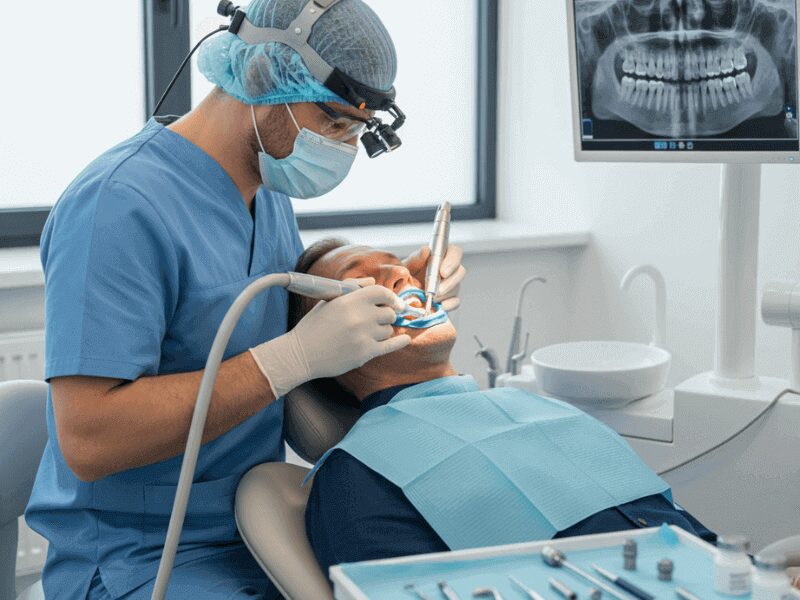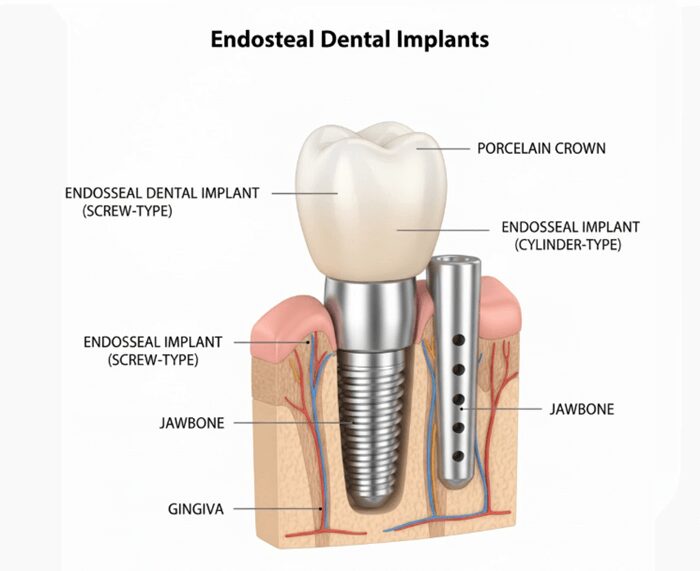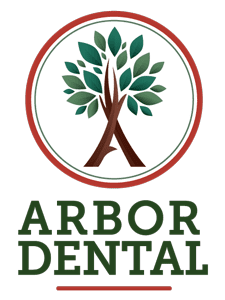Missing teeth can affect your confidence, eating ability, and overall oral health. Dental implants have revolutionized tooth replacement, offering permanent solutions that look and function like natural teeth. But did you know there are 3 types of dental implants, each designed for different jawbone conditions and patient needs?
Understanding types of dental implants is crucial for making an informed decision about your dental restoration. Whether you have sufficient jawbone density or have experienced significant bone loss, there’s an implant type suited to your specific situation. The three main categories, endosteal implants, subperiosteal implants, and zygomatic implants, differ in their placement location, complexity, and ideal candidates.
This comprehensive guide breaks down each dental implant type, helping you understand which solution might work best for your tooth replacement needs.

| Feature | Endosteal Implants | Subperiosteal Implants | Zygomatic Implants |
| Placement Location | Directly into the jawbone | On top of the jawbone, under the gums | Cheekbone (zygoma) |
| Most Common Use | Standard tooth replacement | Insufficient jawbone height | Severe upper jaw bone loss |
| Surgery Complexity | Moderate | Moderate | Complex |
| Bone Grafting Required | Sometimes | Rarely | No |
| Healing Time | 3-6 months | 3-6 months | 3-6 months |
| Success Rate | 95-98% | 90-95% | 90-95% |
| Best For | Most patients with adequate bone | Patients who can’t/won’t do bone grafts | Patients with severe upper jaw bone loss |
Type 1: Endosteal Implants – The Most Common Dental Implant Choice

Endosteal implants are the gold standard in dental implant technology, accounting for more than 90% of all dental implant procedures performed worldwide. The term “endosteal” comes from the Greek words meaning “in the bone,” which perfectly describes how these implants work.
How Endosteal Implants Work
These implants consist of small titanium posts or screws that are surgically placed directly into your jawbone. The titanium material integrates with your natural bone through a process called osseointegration, creating a stable foundation that mimics a natural tooth root. Once the implant fuses with the bone, a connector piece (abutment) and artificial crown are attached to complete the restoration.
Endosteal implants come in various shapes, including:
- Screw-type implants (most common)
- Cylinder-type implants
- Tapered implants for immediate placement
Who Are the Ideal Candidates?
You’re likely a good candidate if you have adequate jawbone density, healthy gums, and good overall health. The process involves surgical placement of the titanium post, a 3-6 month healing period for osseointegration, abutment placement, and finally crown attachment.
The Endosteal Implant Procedure
The process typically involves multiple stages:
- Initial consultation and 3D imaging to assess bone structure
- Surgical placement of the titanium post into the jawbone
- Healing period of 3-6 months for osseointegration
- Abutment placement after the implant has fused
- Crown attachment to complete your new tooth
Advantages and Disadvantages
Benefits:
- Highest success rate (95-98%)
- Most natural look and feel
- Long-lasting solution (20+ years with proper care)
- Preserves jawbone density
- Functions like a natural tooth
Drawbacks:
- Requires sufficient bone density
- May need bone grafting if bone loss has occurred
- Longer treatment timeline (several months)
- Higher initial cost compared to traditional dentures
Type 2: Subperiosteal Implants – Alternative for Low Bone Density

Subperiosteal implants offer a solution for patients who don’t have enough healthy jawbone for traditional endosteal implants and prefer to avoid bone grafting procedures. These implants sit on top of the jawbone but beneath the gum tissue, making them a unique alternative in the world of dental implant types.
Understanding Subperiosteal Design
Unlike endosteal implants that go into the bone, subperiosteal implants feature a custom-made metal framework (usually titanium or chrome-cobalt alloy) that rests on top of the jawbone, just under the gum line. Metal posts protrude through the gums to hold the prosthetic teeth in place. The framework is designed to fit the contours of your specific jawbone structure.
When Are Subperiosteal Implants Recommended?
Dental professionals recommend this dental implant type when jawbone height is insufficient, you want to avoid bone grafting, you’ve experienced bone resorption but retain some structure, or medical conditions make extensive bone surgery risky.
The Subperiosteal Implant Process
The procedure has evolved with modern technology:
- 3D CT scan or dental impression to map your jawbone
- Custom framework fabrication based on your bone structure
- Single-stage surgery to place the framework under the gum tissue
- Healing period of 2-6 weeks for soft tissue recovery
- Prosthetic attachment once healing is complete
Modern CAD/CAM technology has significantly improved the accuracy and fit of subperiosteal implants, reducing complications and improving comfort.
Pros and Cons
Advantages:
- No bone grafting needed
- Suitable for patients with bone loss
- Shorter surgery time than bone augmentation
- Good option for multiple tooth replacement
- Single-surgery procedure (typically)
Disadvantages:
- Less common, so fewer dentists offer them
- Slightly lower success rate than endosteal implants
- May cause gum irritation if framework shifts
- It can be more expensive due to custom fabrication
- Not suitable for all bone loss situations
Type 3: Zygomatic Implants – Advanced Solution for Severe Bone Loss

Zygomatic implants represent the most innovative and complex option among the 3 types of dental implants. These specialized implants are specifically designed for patients with severe upper jaw bone loss who would otherwise need extensive bone grafting or be told they’re not candidates for dental implants at all.
What Makes Zygomatic Implants Different?
The key difference lies in their placement: instead of anchoring into the upper jawbone (maxilla), zygomatic implants are anchored into the zygomatic bone, your cheekbone. These implants are significantly longer than traditional implants, measuring 30-55mm in length compared to the standard 10-15mm for endosteal implants.
This innovative approach bypasses the need for the upper jawbone entirely, utilizing the dense, stable cheekbone structure that rarely experiences bone loss.
When Are Zygomatic Dental Implants Necessary?
This advanced implant type becomes necessary when you have severe upper jaw bone loss from long-term tooth loss, multiple failed bone grafting procedures, trauma, or tumor damage to maxillary bone, or want immediate teeth replacement without waiting for bone grafts to heal.
The Zygomatic Implant Procedure
This sophisticated procedure requires an experienced implant surgeon:
- Comprehensive 3D imaging (cone beam CT scan) to map sinus cavities and bone structure
- Surgical planning using specialized software
- Placement surgery where 2-4 zygomatic implants are inserted through the maxillary sinus into the cheekbone
- Immediate temporary teeth can often be attached the same day
- Healing period of 3-6 months for complete osseointegration
- Final prosthetic placement for permanent restoration
Many patients receive “teeth in a day,” meaning temporary prosthetic teeth are attached immediately after surgery, allowing you to leave the office with functional teeth.
Benefits and Considerations
Advantages:
- Avoids the need for bone grafting entirely
- Solution when other implant types aren’t possible
- Faster overall treatment timeline
- Immediate function with temporary teeth is often possible
- High success rates (90-95%) despite complexity
- Provides full-arch restoration with fewer implants
Considerations:
- Most complex and invasive procedure
- Requires a highly specialized surgeon
- Higher cost due to complexity
- Potential sinus complications (rare)
- Longer surgery time
- More extensive post-operative recovery
- Limited availability (not all implant dentists offer this option)
Which Type of Dental Implant Is Right for You?
Choosing among the 3 types of dental implants requires professional evaluation of multiple factors.
Key Selection Factors
Jawbone condition is the primary factor. A cone beam CT scan reveals bone height, width, density, and anatomical structures. Adequate bone supports endosteal implants, minimal bone suggests subperiosteal options, and severe upper jaw bone loss points toward zygomatic implants.
The location of missing teeth matters significantly. Single gaps typically use endosteal implants, multiple missing teeth may benefit from subperiosteal frameworks, and complete upper arch loss often requires zygomatic solutions.
Overall health and medical history influence safety and success. Active gum disease must be treated first, and conditions like uncontrolled diabetes, osteoporosis, or blood-clotting disorders require special consideration.
Budget considerations are practical: endosteal implants cost $1,500-$6,000 per tooth, subperiosteal implants $2,000-$7,000+ due to customization, and zygomatic implants $10,000-$25,000+ due to complexity.
Importance of Specialist Consultation
Seek consultation with qualified professionals, periodontists, oral surgeons, prosthodontists, or board-certified implantologists. Expect comprehensive examination, 3D imaging, discussion of goals, treatment options review, realistic timelines, and transparent cost breakdowns. Don’t hesitate to seek second opinions for complex cases.
Wrapping Up
Understanding types of dental implants, endosteal, subperiosteal, and zygomatic, empowers you to make informed decisions about tooth replacement solutions.
Endosteal implants remain the first choice for patients with healthy jawbones, offering the highest success rates and most natural results. Subperiosteal implants provide alternatives for those with insufficient bone height who want to avoid grafting. Zygomatic implants represent breakthroughs for patients with severe upper jaw bone loss.
Each type of dental implant has specific applications and advantages. The right choice depends on your unique bone structure, oral health, and personal preferences. With success rates exceeding 90% across all three types of dental implants, modern implant dentistry offers reliable solutions for virtually every patient.
Schedule a consultation with a qualified implant specialist to discover which dental implant type can restore your smile and quality of life.



